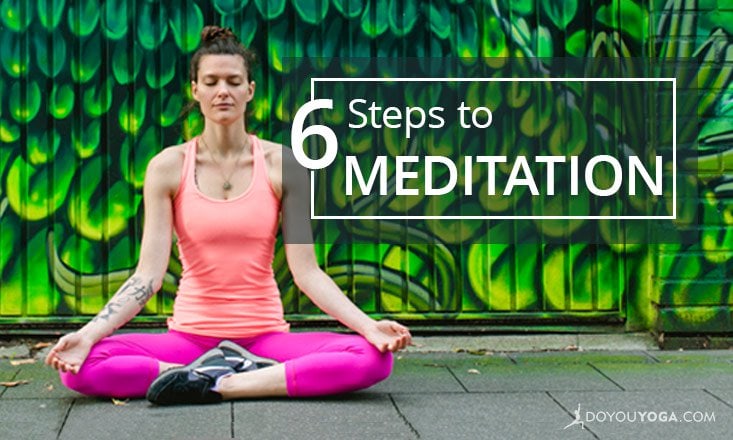Meditation can be one of the most challenging pieces of the yoga practice. As a culture of doers, we often struggle with the simple act of sitting still.
In our daily lives we prize fast-paced environments, we’re constantly submerged in a barrage of quickly changing stimuli. Most of us have no idea how to slow down and tune out.
These six steps will help you to build up a meditation practice that leaves you feeling calmer, centred, and more capable of dealing with the stresses of modern life.
1. Show up.
As Woody Allen says, “Showing up is 80 percent of life.” Simply committing to getting onto your meditation cushion every day is the most important, and possibly the most difficult step.
A few tips to help you arrive:
Clear space.– In order to start reducing the mental clutter, we must first remove some of our physical clutter. Find a space at home or at work that you can keep relatively clean and clear of furniture. Turn off your phone and email notifications and, if possible, place electronic devices in another room.
Carve out a time.– A meditation practice thrives on consistency. Create a habit of practicing at roughly the same time each day. Start small—commit to 15 minutes a day for a few weeks and slowly increase your time from there. A meditation timer can be a really helpful tool in keeping you on track.
Make it a ritual.– Find ways to make the practice beautiful. Setting up a simple altar with a few precious objects or photos, lighting a candle, or chanting a simple mantra to start your meditation are ways to transform a dry habit into a treasured part of your day.
2. Surrender.
Once you’ve found your way onto your meditation cushion, arriving at a comfortable posture is key. It’s perfectly fine to sit in a chair if needed. Start to bring your awareness to points of contact with the floor. Notice how the legs and hips root towards the earth.
If you’re sitting in a chair, notice the weight of the feet on the floor, and your pelvis as it settles into the chair. Continue to move your awareness through the body, looking for a sense of ease in the knees, spine, hands, eyes.
Stay alert in your posture without creating stiffness. Your hands may rest on your knees or in your lap. The eyes may be closed, or open with a soft gaze. The key is to release any patterns of tension or holding in the body. Allow yourself to relax into the meditation pose.
3. Stabilize.
Bring your attention to your breathing. Travel with the breath through the inner spaces of your body. Begin to notice more specifically how your breath feels: its rhythm, speed, temperature, texture.
Notice if the breath is deep or shallow. Notice where the breath moves easefully in the body and where it encounters blocks or tightness. Start to look for a more even sense of breath throughout the body. See if you can invite breath into the spaces that feel closed.
As you become more finely attuned to the pattern of your breathing, begin to use your exhales to gather strength or energy from the base of the body up towards the navel. Find a sense of core stability in each out-breath, while continuing to soften around the hips, shoulders and face.
4. Lighten up.
Allow the breath to become slower and fuller. Continue to stabilize and soften on your exhales, while using the inhales to create lightness in the body. See that each inhale lifts and expands the ribcage. Feel as you’re inhaling that you are radiating upwards and outwards from your centre.
As you grow taller and wider with each inhale, allow yourself to take up the space that you deserve. Feel that you begin to breathe beyond the boundaries of your skin, that the breath dissolves the border between where you end and where everything else begins.
5. Listen.
As you continue to focus on your breath, notice what thoughts arise. Try to observe the thoughts without attaching to them. Notice when you get caught up in a story that leads you away from your breath.
In the course of meditation, we often get distracted many times. Don’t berate yourself for losing the thread of concentration, rather gently guide your attention back to your breath. Once we dismantle the stories that tend to create noise or distortion at the surface of our consciousness, deeper wisdom can arise. Listen for any revelations and discoveries that may bubble up.
6. Integrate.
Take a few moments after you come out of your meditation to write down what you noticed or felt. Meditation can be a very ethereal experience, and journaling may help to solidify the process.
As you practice over weeks and months, notice the shifts that arise in your everyday life. Perhaps you find yourself pausing before you react in stressful situations. Perhaps you feel less frazzled by the pressures of your life.
Observe how your meditation practice allows you to let go of patterns that no longer serve you, while creating a space to invite new possibilities in.


